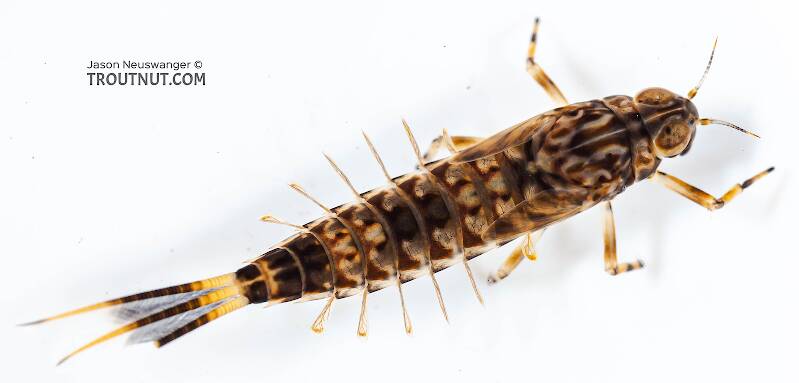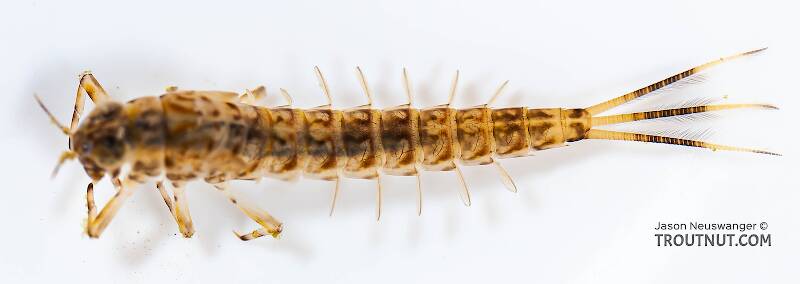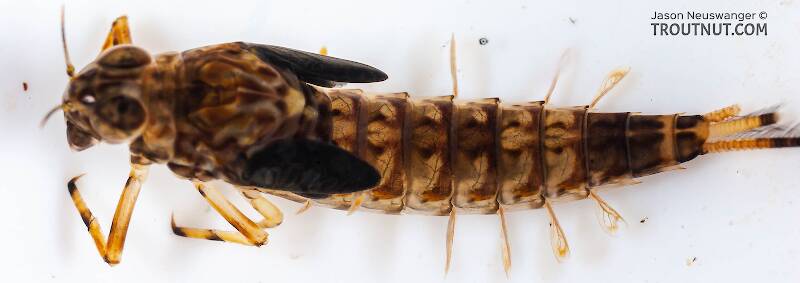
Salmonflies
Pteronarcys californica
The giant Salmonflies of the Western mountains are legendary for their proclivity to elicit consistent dry-fly action and ferocious strikes.


Mayfly Species Ameletus ludens (Brown Duns)
Species Range
Hatching behavior
Fred Arbona notes in Mayflies, the Angler, and the Trout that the best Ameletus ludens hatches come on cloudy days.Physical description
Most physical descriptions on Troutnut are direct or slightly edited quotes from the original scientific sources describing or updating the species, although there may be errors in copying them to this website. Such descriptions aren't always definitive, because species often turn out to be more variable than the original describers observed. In some cases, only a single specimen was described! However, they are useful starting points.
Male Spinner
Wing length: 9 mm
A rather small clear-winged brownish species, with distinct blackish oval ganglionic marks on the venter of the abdomen.
Head of male blackish. Eyes of male honey-colored in life. Thorax reddish brown. Mesonotum yellowish to olive brown; scutellum reddish yellow; the area just anterior to it cream colored, and a pale cream colored patch on each lateral margin. Metanotal scutellum rather similarly marked. Anterior to the wing root is a pale cream colored area varied with a reddish tinge; similar patches on the pleura. Sternum blackish in the male. Fore legs dark reddish brown; middle and hind legs brown. Wings hyaline, veins blackish brown. Stigmatic cross veins tend to anastomose. Abdomen of male semi-translucent except on the apical segments; pale yellowish brown above, paler beneath. Basal and apical segments washed with reddish brown. Rather wide dark brown bands on the posterior margins; postero-lateral angles dark brown. Sternites paler than tergites; apical sternites opaque reddish brown. Each ganglionic area is marked by a blackish oval spot, having a distinct black line through the center. Posterior margins, behind the dark bands, narrowly pale. Margin of pleural fold pale. Apical tergites and sternites often marked with creamy white areas which are tinged with red. Basal sternites pale, semi-translucent; apical sternite opaque. Forceps blackish, tawny at the base. The long joint of the forceps is swollen basally and distally. The penes are long and slender, slightly divergent distally (see fig. 116). Tails dark reddish brown basally, becoming somewhat paler distally. Joinings darker.
Female Spinner
Wing length: 9 mm
Nymph
The mature nymph is dark reddish brown with cream colored markings. Legs pale, banded with brown. Abdominal tergites 8-10 very dark brown; basal and middle tergites varied with indistinct paler median, lateral and posterior markings. Dark brown oblique submedian marks present. Postero-lateral spines on segments 4-9, very small on 4 and 5. Ventrally, three very wide dark reddish brown bands occupy most of each sternite. These bands coalesce completely on sternites 8 and 9, and are more or less diffuse on the other sternites. No distinct pale streak separates the lateral dark line from the lateral margin of the sternite. Tails with the usual dark bands. This species is of particular interest in that it ordinarily reproduces parthenogenetically.
Specimens of the Mayfly Species Ameletus ludens
3 Nymphs
Discussions of Ameletus ludens
I came upon a woodland swarm late this evening. I thought I saw mating occurring higher above the stream. This would mean that parthenogenesis is not necessarily happening in "my" stream. I watched for awhile, but got distracted (venomous snake). I hope to catch it (the hatch, not the snake) again tomorrow night and note the egg-laying behavior and possibly nab some male adults for science. There's a range of nymph ages, so I should be OK, weather permitting.
Start a Discussion of Ameletus ludens
References
- Arbona, Fred Jr. 1989. Mayflies, the Angler, and the Trout. Nick Lyons Books.
- Baumann, Richard W. 1975. Revision of the Stonefly Family Nemouridae (plecoptera) : a Study Of The World Fauna At The Generic Level. Smithsonian Contributions to Zoology undef(211): 1-74.
- Caucci, Al and Nastasi, Bob. 2004. Hatches II. The Lyons Press.
- Knopp, Malcolm and Robert Cormier. 1997. Mayflies: An Angler's Study of Trout Water Ephemeroptera . The Lyons Press.
- Needham, James G., Jay R. Traver, and Yin-Chi Hsu. 1935. The Biology of Mayflies. Comstock Publishing Company, Inc.
Mayfly Species Ameletus ludens (Brown Duns)
Species Range
Common Name
Resources
- NatureServe
- Integrated Taxonomic Information System
- Global Biodiversity Information Facility
- Described by Needham (1905)




